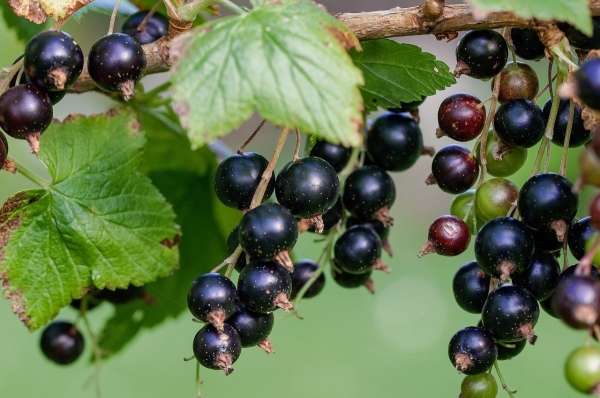In garden practice, there are often situations that require transplanting currants to a new place. Most often this is due to an error during site selection, depletion of the soil under the bush or redevelopment of the site.
Transplanting adult shrubs to another place - great stress for the plant, which is accompanied by pain and often leads to his death.
Therefore, the procedure should be carried out taking into account the biological features and the annual cycle of currant.
Table of contents
When is it better to transplant currants to a new place: in the fall or spring, in what month?
Which month is more favorable? The dates of currant transplantation are completely dependent on the climatic conditions of the region. In regions with severe winters with a decrease in air temperature below 30 ° C, spring transfer is preferable.
But at the same time, it is important to take into account the peculiarities of the annual cycle of the culture, which enters the growing season early. After the start of sap flow, the shrub will receive a double load, trying to root and at the same time increasing the green mass.
Spring transfer carried out after complete thawing of the soil, the temperature rises to + 1 ° C and before the kidneys swell. This limits the time of transplantation, reduces the time for quiet rooting to three weeks.
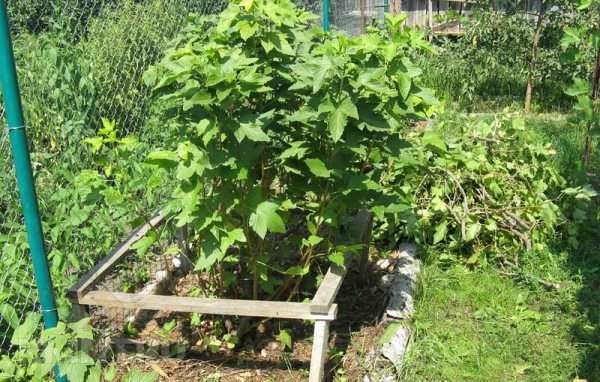
Favorable factors in the autumn transplant currants much more. This is a stable temperature until the first frost, which gives time to adapt the roots to a new place.
In addition, in the cells of the currant in the fall is much more nutrients and a downward current prevails, which contribute to the rapid healing of wounds of the roots and give strength to recover.
Therefore, in the middle and southern regions of gardening shrub prefer to transplant in the fall. It is important to determine the most accurate dates, before the first frost should be at least three weeks.
The stages of proper transplanting adult shrub
The basis of successful transplanting adult shrubs - the right choice of place, preparation of soil and bushes.
Selection and preparation of the site
Red and white currant - thermophilic plants. For them, select leveled areas, oriented to the south or south-west direction. In such areas, the soil is heated by sunlight, well aerated and water does not stagnate.
Black and green currant less whimsical plants.Good indicators of stable yield are observed when planting on the slopes of the northern or northeastern direction. Short-term shading is permissible.
Unsuitable for growing lowland currants and closed hollows, where cold air stagnates and humidity is increased. This contributes to the development of fungal diseases and the emergence of root rot.
The chosen place is dug up in early spring to a depth of 40 cm with fertilization per 1 m2:
- 10 kg compost or manure;
- double superphosphate 10 g;
- potassium chloride 7 g.
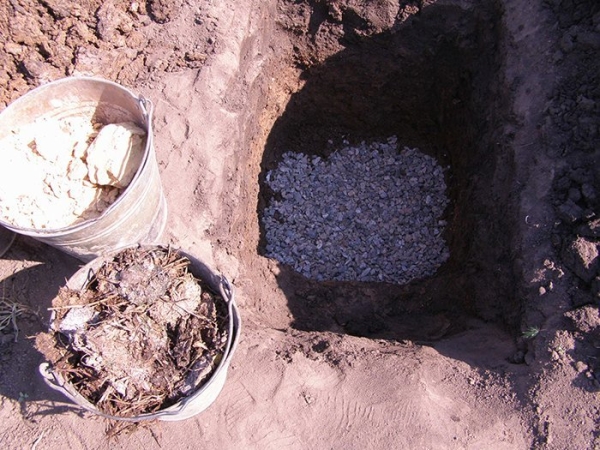
In the summer, in August, the site is dug up again and form a pit for shrubs. For the spring transplant site is prepared in the fall.
Determining the size of the pits, are guided by the volumes of the shrub. In most cases enough depth 40 cm and width 60 cm. For tall and remontant varieties will require a depth of 60-70 cm. The distance between the bushes is at least 1.5 meters.
After digging the pit 1/3 filled with substrate from the mixed components:
- top layer of garden soil from the pit;
- rotted manure or compost 10 kg;
- superphosphate 300 g (for black currant) 200 g (red, white);
- wood ash 400 g or potassium sulfate 30 g
For the red and white currants, the hole is dug deeper and at the bottom form a drainage layer of expanded clay or broken brick, not more than 15% of the total.
Thereafter a hole is spilled by 1-2 buckets of water. Before the currant is transplanted inside the pit, all conditions will be created for the comfortable adaptation of the roots.
Currant Transplant:
Preparation of a bush of red and black currant
During transplantation, the volume of the roots of the shrub will significantly decrease, which makes it difficult to feed the vegetative mass. Therefore, currants 2-3 weeks before the upcoming event cut off, leaving only areas significant for fruiting and development. When autumn planting pruning can be done in the spring, before the swelling of the kidneys.
At the base of the shrub there is a branch zone.From it grow strong side shoots, at a height of 30-40 cm begins fruiting zone, characterized by weak branching. The shoots here are short, but with developed flower buds, so most of the crop is located on them.
On top of branches also form fruit buds in large quantities, which are noticeably weaker and produce only small berries. Therefore, the main branches of the shrub cut by 1/3, without fear of harm to the harvest of the next season. After pruning, the average height of currants should be 45-50 cm.
Efficiency currant 5 years old, there is no sense to leave outdated branches on a bush. The development of currants impede pups, suckers and dried branches, they should also be removed.
You can transplant to another place!
During the transplant around the trunk circle, they dig a groove 30-35 cm deep, stepping back 40 cm from the trunk. After that, gently pull the shrub at the base of the branches that hold the roots to cut with a bayonet.
For the convenience of the event currant branches bind like a spindle. Additionally, it will protect against breakage of fruit branches. An excavated shrub is placed on a canvas to be transported to the landing site.
Further inspect the roots, clean them from pests, cut off the dried and rotted areas. Carry out the procedure of disinfection, placing the roots of the plant in a 1% solution of potassium permanganate for 15 minutes.
Shrubs with healthy roots are transplanted without prior treatment.
At the bottom of the landing fossa form a mound of the prepared substrate and shed 1-2 buckets of water. After that, wait until the water is absorbed. Planting in too wet an environment will lead to excessive shrinkage of the shrub, which often causes improper development.
Also take into account that the root neck of the shrub should remain 5 cm below the surface of the substrate.
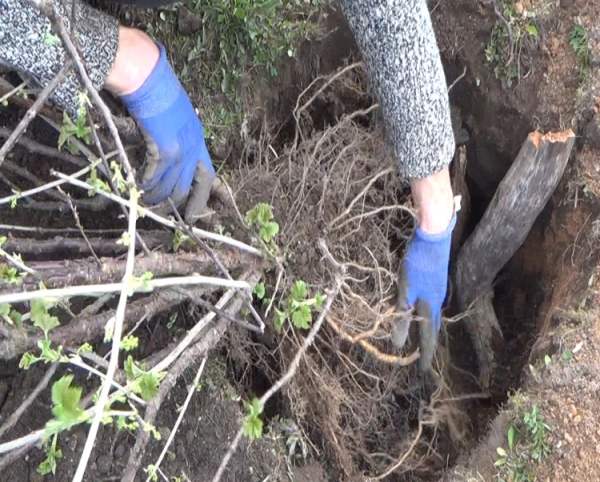
Regarding the sides of the world, currants are placed in the same way as before. Currant roots are distributed over the surface of the hill, preventing unnatural bends upward.
During the backfilling of the roots, it is ensured that no voids form.which often become causes of decay. To do this, during the procedure, the shrub is periodically shaken.
Surface tamped and around the trunk circle form a hole for watering. Water (20 l) is poured gradually, waiting for full absorption. With this irrigation water completely covers the roots, increasing their contact with the soil.
After this, the trunk circle and the hole is mulched with peat, humus or soddy soil.
Care after
After transplanting shrubs need help gardener. The soil in the hull circle is maintained in a constantly loose state.. This is necessary to create the optimal balance of water and air for proper nutrition and respiration of the roots.
At the base of the shrub loosening is carried out at a depth of 5-6 cm, closer to the watering hole up to 15 cm.
In the fall, the shrubs are prepared for winter:
- clear the near-stem circle of plant residues;
- lay a layer of mulch from peat or straw at least 15 cm in height;
- cover shtamb spherical;
- carry out spraying fungicides;
- the branches are collected to the center and tied with twine;
- pull up to the bush snow.
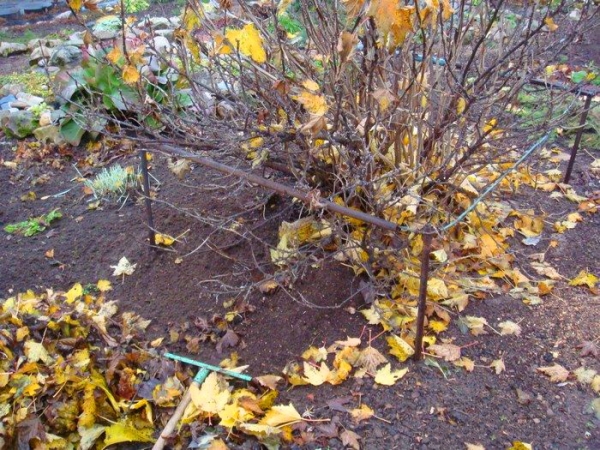
In the first two weeks after landing, if there is no rain, need regular watering every other day. So that the soil is moistened to 60 cm in depth. 3-4 buckets of water are used for this.
In the first year feeding currants will not be needed. After two weeks, irrigation periods are determined by the condition of the soil under the shrub.
Weakened shrubs are most attractive for pests and diseases.that explains the temporary loss of stability. Therefore, the task of the grower in this period is complete control over the currant, especially in the first year of development.
BUT insecticides and fungicides can help., which can be prepared from herbal ingredients or purchase ready-made preparations.
How to safely transplant a currant bush, part 1:
How to safely transplant a currant bush, part 2:
